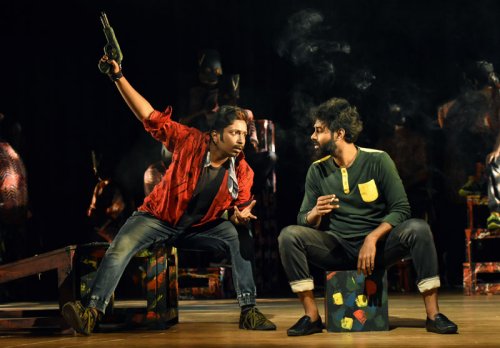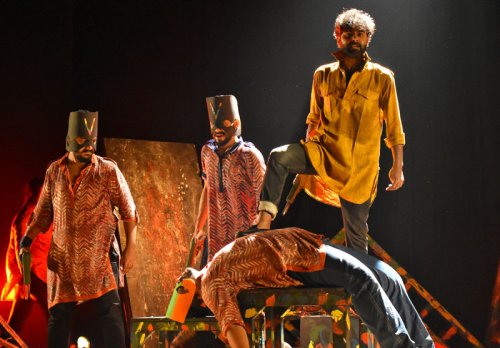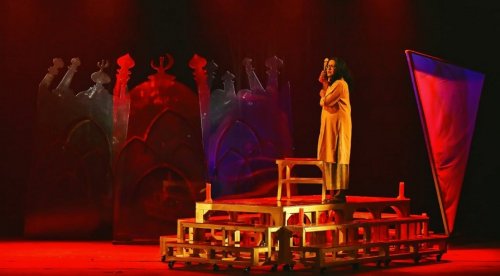
|   |

|   |
 e-mail: ukb7@rediffmail.com Both acerbic and cathartic April 10, 2020 Bertolt Brecht and Luigi Pirandello have been two major phenomena in the European theatre-scape. Set poles away from the Greek narrative structure and neatly demarcating tragedies from comedies - not much deviated from, by the Shakespearean oeuvre in the form and treatment -- both Brecht and Pirandello have been bent into unraveling the society's underbelly and exposing the ills and the misbegotten. Both these playwrights are darlings of the eastern metropolitan spectators and are showcased with loving care to its theatre cognoscente from time to time. In the two plays under review, while Brecht cocks a snook at the warped society of his time and launches a virulent "Theatre of Protest" on his own, Pirandello delves into a shimmering, psychedelic world and is indeed on the same plane as Jean Genet and Samuel Becket, hovering close to "Theatre of the Absurd" that materialized only in the subsequent century. Money, muscle-power, media, motherland Bertolt Brecht (1898-1936) was a German theatre practitioner, playwright and poet. Coming of age during the Weimar Republic, he began writing plays in Munich and later moved to Berlin in 1924. Immersed in Marxist thought, he became a theoretician of epic theatre. During the Nazi period he lived in exile, first in Scandinavia, and during the World War in the USA, where he was subpoenaed by the House Un-American Activities Committee. Returning to East Berlin after the War, he established the theatre company Berliner Ensemble with his wife and collaborator, actress Helene Weigel. Brecht's play Resistible Rise of Arturo Ui (English version completed in 1941, but first produced in 1958) is consciously a highly satirical allegory of Hitler's rise to power in Germany and the advent of the National Socialist State. All the characters and groups in the original play had direct counterparts in real life and the cast-sheet virtually read like the Nazi Germany's who's who! Thus, the hero 'Ui' represented Hitler; his henchman 'Roma' was Röhm, head of the Nazi Brownshirts; 'Dogsborough' was General Hindenburg, President of the Weimar Republic; 'Giri' was Göring, Hitler's second-in-command; 'Givola' the master propagandist Goebbels; 'Cauliflower Trust' the Prussian Junkers, and so on. Every scene in the play was based on a real event. For instance, the warehouse fire represented the notorious Reichstag fire, and the Dock Aid Scandal meant the Eastern Aid scandal. 

Vitton, presented on March 8, is a faithful Bengali version of the above play done by 'Pacham Vaidik' and closely follows the original text, including Brecht's 'epic' style of theatre. Directed and adapted by Arpita Ghosh, it thus opens with a "Prologue" in the form of a direct address to the audience by an otherwise unidentified "actor", who outlines all the major characters and explains the basis of the upcoming plot. This allows the audience to focus better on the message rather than being concerned about what might happen next in the plot. The Bengali play skillfully chronicles the rise of a fictional mobster, Vabesh Nath alias Vitton, and his attempts to control politics, mobilizing the local business community and ruthlessly disposing of the opposition. Vitton starts with the agitation of the Association of Vegetable Merchants in deep economic distress, since the bank has refused their working capital loan. The Association approaches the local political leader, Samaddar (well-enacted by Babu Dutta Roy). But he declines to help and, instead, hatches a plan to take over the factory of one Sanyal, taking advantage of the latter's financial instability. (Originally, Brecht allegorized this episode to the Eastern Aid Scandal in German history). The gangster of the area, Vitton (superbly donned by Arna Mukhopadhyay), secretly cherishes the desire to become Numero Uno. Having acquired money and muscle power, he now intends to venture into politics. Learning about Samaddar's betrayal of his civic body and unscrupulous means to acquire a factory, he tries to blackmail Samaddar and demands his public support to attain political fame. When Samaddar refuses, Vitton leaves, but not before threatening: "One day Samaddar shall bend down to my command and join me in order to establish me in politics!" The investigation begins on the shady dealings surrounding the factory acquisition and how Samaddar eventually had agreed to become a guarantor for the bank loan. Summoned to clarify, Samaddar is forced by Vitton to bring him in the court as his "representative", but meanwhile the news arrives that Sanyal, the factory owner, has been found dead. The City Clerk formally accuses Samaddar of "abuse of the public trust" and calls his chief witness in his defense. However, the latter who could vouch for those shady dealings, was shot dead in public! The City Clerk is forced to give up his inquiry, leaving open the question: who shot the chief witness? Samaddar, however, gets indebted to Vitton for own legal rescue, but is entrapped; he cannot risk his political reputation acquired over a long time, nor can he risk trying to stop Vitton. The latter takes advantage of this dilemma, moves into the vegetable business by demanding "protection" money from the merchants and sends "agents" to openly threaten the business members. "What's their choice: murder or 'protection'?" If anyone resists, his warehouse would be burnt to the ground, with gangsters fully acquitted! (Brecht had related this episode to the Reichstag fire). As to how Vitton bribes Basak, another senior political leader, to let him join the ruling party so that ultimately he could rise to "the top"; how he receives "lessons" from an actor in gesture, posture, grooming and public speaking (uncannily similar to what Hitler did!); how he invites Dasgupta, a press baron, and offers to introduce his "protection" to the neighborhood, but who gets murdered for his very valid disagreement; how another business leader Ghosh stands against Vitton and joins hand with Giri, Vitton's "Number Two", for using a fake "confession statement" to blackmail Vitton so that Giri could be the next top leader; how Vitton's henchman, Rabi, senses this treachery and informs Vitton that Giri and Ghosh were plotting against him; how Ravi, to prove himself loyal to Vitton, intends to kill Samaddar; how there is undiminished revenge and counter-revenge and the racket of "protection"; but how Vitton gets to "the top" exactly as he had wanted, is the warp and weft of the remaining complex story. The gruesome play ends with the message of the overshadowing of Money, Muscle and Power - with Media already subdued over diaphanous politics, illustrating "how fascist takeovers can happen anywhere in the world," as says the brochure. The story - rather "the real life experience of Nazi Germany" - is narrated in some detail above due to its sinister and gory implications, although a close - or remote -- resemblance to any modern country or any recent events will be merely coincidental. It was a premiere show and Arpita's very conscientious handling of a Brechtian masterpiece, together with an imaginative set, skilled lighting and well-rehearsed team effort, will be remembered long afterwards. Illusion, fantasy, delusion, reality Luigi Pirandello (1867- 1936) was an Italian dramatist, novelist, poet, and short story writer whose greatest contributions were his plays. The 1936 award of Nobel Prize to him cited: "his almost magical power to turn psychological analysis into good theatre." Pirandello's tragic farces are often seen as forerunners of the 'Theatre of the Absurd.' In his 1884 play, Henry IV, a 19th-century aristocrat falls off a horse and becomes convinced that he is Henry IV, the emperor who ruled Rome in the 11th century. Oddly, the friends and relatives of the accident victim do not attempt to dissuade him and instead, play along with his delusions. As a royal court is built around "Henry," his psychiatrist attempts to figure out if the faux noble is truly insane, or, if he is merely milking his madness for all it is worth!  In its Bengali adaptation, the iconic director-actor Ajitesh Bandyopadhyay, located the play in the late 16th century Bengal when the stunningly beautiful Nur Jahan was the 20th queen of Emperor Jahangir, who had snatched her away from his Jagirdar Sher Afghan in Burdwan. In a historical play Nur Jahan based on these events, the lead actor -- playing the role of Sher Afghan -- falls on the stage and is seriously hurt in the head. He leads the imaginary life of the protagonist for the next 25 years as a hallucinating recluse -- surrounded by willing friends complete with the make-up of the Jagirdar's court! In make-believe sequences, the surging conflicts within his memory between his physical and mental states are dramatically acted out. The reality and fantasy, the logical and the illogical get commingled in trying to define his identity and, in his "willing suspension of disbelief", the erstwhile actor gets entangled permanently in his own schizophrenic world! (Based on the above script, the play was originally produced by 'Nandikar' with a memorable donning of the main role -- in a tender and compassionate understanding with his encircling friends -- by Ajitesh himself and is fondly remembered by many, including this critic.) Sher Afghan, presented on March 12 by 'Sansriti', faithfully followed the script and carried the flag quite well. Directed by the veteran Debesh Chattopadhyay, the performance was marked by well-orchestrated teamwork and the noted actor Rajatava Dutta acquitted himself expertly as the delusional patient - floating between the real and the unreal forever. Sudipa Basu, who played the role of the beautiful queen half a century ago and oscillates now between joy and despair, was true to her character. The sets, lighting and the scenography (also by the director) were indeed very well done.   Extracts of an interaction with the director: What drew you to this play by Pirandello? I found that this play excels not merely in its dramatic potential, but also in the confrontation between reality and imagination created in a kaleidoscopic virtuosity of color and texture that hammer away on the philosophy of conventional theatre. Here is one set of actors who are well-set, with mutual consent, in the world of Sher Afghan's "court", and they are confronted by an outside band of actors - accompanying the psychoanalyst - who are trying to extract the truth from this bizzare situation. What is the play's relevance today? Ours is decidedly a "virtual world" where we are trying to discover the ultimate truth from its multi-dimensional complexity. Pirandello's play pushes us to grapple with the relativity of truth where tragedy and comedy co-exist side by side. In Pirandello's depiction, this tragic-comic text creates its own abstract burlesque! What has been the process of your treatment? In my own imagery, the actor in this play is a puppet, as it were, whose face is covered by a mask. In my construction process, the actor selects his own dialogue from day one, from out of the entire material of the play. It's not a dialogue learnt by rote, but a "biological process" during which his dialogue takes shape, bit by bit, in the daily rehearsal of twelve hours. Can you elaborate? Drawing an analogy from Natya Shastra, this is like the actor arriving with his Aharya and then using his Sattvik act to glue together the Angik and Vachik, and let them seep into his unconscious. This process of building a play's production is very indigenous to our country's ethos, where the director does not show his actor the composition, but only helps to identify the space.  Dr. Utpal K Banerjee is a scholar-commentator on performing arts over last four decades. He has authored 23 books on Indian art and culture, and 10 on Tagore studies. He served IGNCA as National Project Director, was a Tagore Research Scholar and is recipient of Padma Shri. Post your comments Please provide your name and email id when you use the Anonymous profile in the blog to post a comment. All appropriate comments posted with name and email id in the blog will also be featured in the site. |